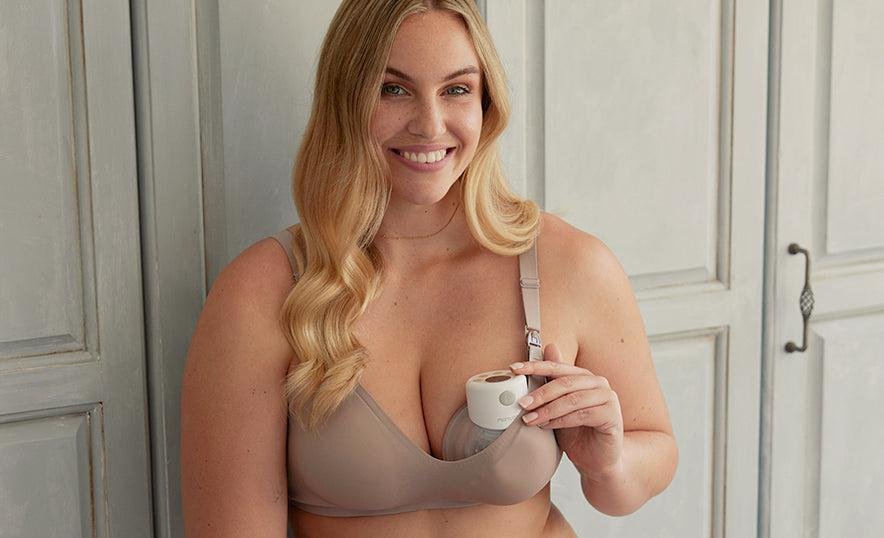As a new mom, you’ve likely found yourself wondering something you never thought you would: Should you sleep in a nursing bra? This simple action can affect the comfort of your night and your overall breastfeeding experience. The postpartum period ushered in a lot of emotional and physical changes, all demanding due balances of comfort and support. Your body is hard at work nourishing your newborn, so proper support relieves discomfort and may even help prevent problems. But comfort is important too – after all, good sleep is a highly prized commodity for new parents.
How Your Breasts Change During Breastfeeding
You will notice several changes with the onset of motherhood. That is because your body starts preparing itself to feed your new little bundle of joy, and you will find a few changes in the look and feel of your breasts during this time.
1. Size and Weight Increase
Your breasts will enlarge and feel heavier. You may grow out of your old bras very soon. You will perhaps experience a sensation that you are full and tight, usually during the early period. This can create some discomfort while making certain sorts of movements, as when you reach out high or lie on your stomach. Keep in mind that these are ordinary changes, and your body is simply equipping itself to feed your baby.
2. New Sensations: Tingling and Letdown
You may feel a tingling sensation, which you may not be familiar with, called “letdown.” It is mainly described as either a tingling or warm rush in the breasts. It occurs when your baby starts suckling or even when you hear your baby’s cry. Some mothers feel it quite strongly and others hardly notice it at all.
3. Increased Sensitivity
Your breasts and nipples may be far more sensitive. It can be just a bit uncomfortable or very painful. Even soft fabrics might feel rough on your skin. Be gentle with yourself during this time. Try wearing soft, breathable clothes, avoiding harsh soaps or lotions on your breasts.
4. Changing Fullness Throughout the Day
Once you are established with regular feeding, your breasts will change in size over the course of a day. They are larger before feeding and softer after. This can make finding comfortable clothes tricky. A well-fitting bra in the morning can feel tight by the afternoon.
Should You Sleep in a Nursing Bra If You’re Breastfeeding?
The simple answer is that it depends on your personal comfort and needs. Some breastfeeding moms find that wearing a nursing bra at night can be very helpful for them, while others prefer sleeping without one. There’s no right or wrong choice here – it is what works for you and your body.
1. Extra Support for Comfort
Your breasts are likely fuller now, and this extra weight may be a bit uncomfortable as you lie down. Wearing a soft nursing bra supports this extra weight and can really help you more easily find a comfortable sleeping position. You’re literally giving your breasts a little squeeze all night long. Extra support is especially appreciated during the first weeks when your breasts may get very full.
2. Managing Nighttime Leaks
Leaking milk at night is pretty standard, mainly during the first few weeks. A nursing bra can keep nursing pads in place and prevent your sheets and pajamas from getting drenched with milk. You will be saved from the discomfort of waking up in a wet spot or having to change bedding in the middle of the night. It is one of those easy ways through which nighttime can be made easier and with less mess.
3. Easy Access for Midnight Feedings
A nursing bra—when the baby wakes up hungry—aids in quick and easy breastfeeding. You won’t fuss with buttons or tight clothes when you are half asleep. Most nursing bras have clasps or panels that easily open to feed your baby without fully waking up. This facilitates you and your baby going back to sleep quickly.
4. Emotional Comfort
Some moms feel more secure in a bra at night. If you’re used to wearing a bra all day, keeping one on at night might be similar to just continuing to be in a familiar zone. This emotional comfort can be important as you adjust to changes in your body and routine.
Reasons You Might Not Want to Wear a Nursing Bra at Night
While some mothers like to sleep in a nursing bra for added support and comfort, most would prefer not to go to bed in one. There are valid reasons for this choice too.
1. Potential Circulation Issues
Wearing a very tight bra may hinder good blood flow and somehow affect the milk ducts. Your breasts require proper blood flow if they are to produce milk effectively. If you sleep without a bra, it gives your chest the freedom to move in its natural position and to breathe freely. If you must wear a bra, then make sure it is not too tight. Additionally, when waking up, it shouldn’t leave any marks on your body.
2. Skin Irritation Risks
Wearing a bra for a longer period, especially during hot summer, may provoke skin irritation. Sweating and friction can cause chafing or even a yeast infection in the folds under your breasts. This gives the skin time to breathe and recover at night. This is very important if you have got sensitive skin or you happen to live in a hot climate.
3. Possible Impact on Milk Supply
Some experts believe that even a well-fitting bra, due to its continuous pressure on your breasts, may affect milk production. There’s no hard evidence, but some mothers have reported their supply was maintained or even increased by going braless at night. It’s all in what works for your body and meeting your baby’s needs best.
4. Natural Comfort
Many women simply find it more comfortable sleeping without a bra. After wearing one all day, the night is the time to let those breasts relax naturally. This might help you sleep deeper and wake up feeling refreshed.
What Medical Professionals Say About Nursing Bras at Night

Medical experts offer advice on wearing nursing bras at night based on breast health and comfort. Here’s what they generally recommend:
Support and Comfort
Nursing bras aren’t a must, but many women find them helpful. During breastfeeding, breasts often feel heavier. A nursing bra can provide support and make you more comfortable. It can also help prevent milk from leaking onto your bedding.
Other Options
Some women prefer not to wear a bra at night. Others choose to wear a cami or crop top instead. Experts say your comfort is the most important thing. If a bra feels uncomfortable at night, don’t feel you have to wear one.
Avoiding Tight Bras
Be careful not to wear bras that are too tight. A bra shouldn’t squeeze your breasts or leave marks on your skin. Tight bras can cause problems like blocked milk ducts or mastitis. Choose bras that support gently without pressing on your breast tissue.
Every Woman is Different
There’s no single right answer for everyone. Listen to your body and choose what feels best for you while keeping your breasts healthy.
For personalized advice, talk to your doctor or a breastfeeding specialist. If you decide to use a nursing bra, get fitted a few weeks before your baby is born, as your breast size might still be changing.
Key Features of a Good Nursing Bra for Nighttime Use
If you decide to wear a nursing bra at night, choosing the right one is crucial. Here are the key features to look for in a nighttime nursing bra:
1. Soft and Breathable Material
The fabric of your nighttime nursing bra should be gentle on your skin. Look for bras made from soft, natural materials like cotton or bamboo. These fabrics allow your skin to breathe, reducing the risk of irritation or sweating. A good nighttime nursing bra should feel like a second skin – so comfortable you hardly notice it’s there.
2. Proper Fit Without Tight Compression
A nighttime nursing bra should offer light support without squeezing your breasts. It should fit well but not be so tight that it leaves marks on your skin. Remember, your breast size may fluctuate throughout the day and night, so a bit of stretch in the fabric is helpful. Avoid underwires, as they can dig into your skin and potentially cause blocked milk ducts.
3. Easy Nursing Access
Midnight feedings are much easier with a bra that allows quick and easy access. Look for bras with simple clip-down cups or pull-aside panels. You should be able to open the bra with one hand, even when you’re groggy from sleep. The easier it is to nurse, the faster you and your baby can get back to sleep.
4. Adjustable Features
Your body will continue to change throughout your breastfeeding journey. A bra with adjustable straps and multiple hook-and-eye closures can grow with you. This adaptability ensures you get a good fit as your breast size changes, making the bra a lasting investment.
Comfort is key when it comes to nighttime nursing bras. Take the time to find one that feels right for you. Remember, what works for one mom might not work for another, so don’t be afraid to try a few different styles before settling on your favorite.
Tips for Better Sleep While Breastfeeding
Sleeping well is crucial when you’re breastfeeding, but it can be challenging. Here are some practical tips to help you get more rest:
1. Set Up a Bedtime Routine
Create a calm routine before bed. This might include:
- Taking a warm bath
- Reading a book
- Listening to soft music
- Doing gentle stretches
These activities can help you relax and signal to your body that it’s time to sleep.
2. Make Your Bedroom Comfortable
Create a sleep-friendly space for you and your baby:
- Keep the room dark and cool
- Use a comfortable mattress and pillows
- Consider a white noise machine to block out sounds
- Have everything you need for night feedings within reach
3. Manage Feeding Times
Plan your feedings to get more sleep:
- Try to feed your baby right before you go to bed
- Consider “dream feeding” – feeding your baby while they’re still asleep
- If possible, take turns with your partner for night feedings
Be patient with yourself as you find what works best. It may take time to establish a routine that helps both you and your baby sleep better, but with some trial and error, you’ll find a rhythm that works for your family.
Final Thoughts
When wearing a nursing bra at night, there’s no single right answer for everyone. Your comfort and health should guide your decision. Whether you choose to wear one or not, listen to your body and do what feels best. Try different options, seek advice if needed, and be patient as you adjust. With time, you’ll find the right balance for you and your baby. Trust yourself, and be ready to adapt as your needs change throughout your breastfeeding experience.z












